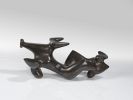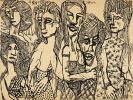
Charles Eames
St. Louis/Missouri
1907 -
St. Louis
1978
Charles Eames studied architecture at Washington University in St. Louis until 1929. He was already working as an architect when he came into contact with Eliel Saarinen, head of the kommt, dem Leiter der Cranbrook Academy of Art in Bloomfield Hills, Michigan, through working on building Meyer House in Huntleigh Village. Friendship with Saarinen's son, Eero Saarinen, would have a formative influence on Eames's subsequent career. In 1938 Eliel Saarinen offered Charles Eames a scholarship to Cranbrook, where Eames studied design and architecture. In 1939 Charles Eames began to teach design at Cranbrook and in 1940 became head of the industrial design department.
Together with Eero Saarinen, Charles Eames took part in the "Organic Design in Home Furnishings" competition mounted in 1940 by the Museum of Modern Art in New York. Charles Eames and Eero Saarinen collaborated with Harry Bertoia, Don Albinson, and Ray Kaiser on the designs they submitted to the New York competition. Their main design, an armchair with a seat and back made of a single piece of three-dimensionally shaped plywood, was awarded a prize but turned out to be unsuitable for mass production.
In 1941 Charles Eames divorced his first wife to marry Ray and the couple moved to Los Angeles, where Charles worked as a set designer for MGM Studios and Ray designed covers for "Art & Architecture Magazine". In their own flat, they continued to experiment with the "Kazam! Machine" press on developing an efficient and economical method for molding plywood in three dimensions. In 1942 Charles and Ray Eames founded the Plyformed Wood Company and made splints and stretchers of molded plywood for the US Navy. Financial difficulties forced the Eames to sell the business to the Evans Product Company, where Charles Eames became head of research and development. In 1946 MOMA mounted a retrospective, "New Furniture by Charles Eames", showing prototypes of the plywood furniture designed up to then by Eames's office. They included the "Lounge Chair, Metal (LCM)" and the "Lounge Chair, Wood (LCW)", which is made of several molded wooden elements. The "LCW" was based on a 1940 design and a further development of it with armrests became the prototype of the famously elaborate Lounge Chair "No. 670" with the "No. 671" footstool (1956). By the 1950s Ray and Charles Eames were also experimenting with fiber glass. They created the revolutionary "Plastic Shell Group" and the elegant curvilinear "La Chaise" chair (1948), which Charles Eames submitted to the MOMA "Low-cost Furniture Design" competition, the "Dining Armchair Rod (DAR)", and the "Rocking Armchair Rod (RAR)" (1948-1950). The year 1958 saw the launch of the Eames "Aluminium Group". The furniture designed by Charles und Ray Eames is made mainly by Herman Miller and Vitra.
Would you like to sell a work by Charles Eames?
Infos for seller









